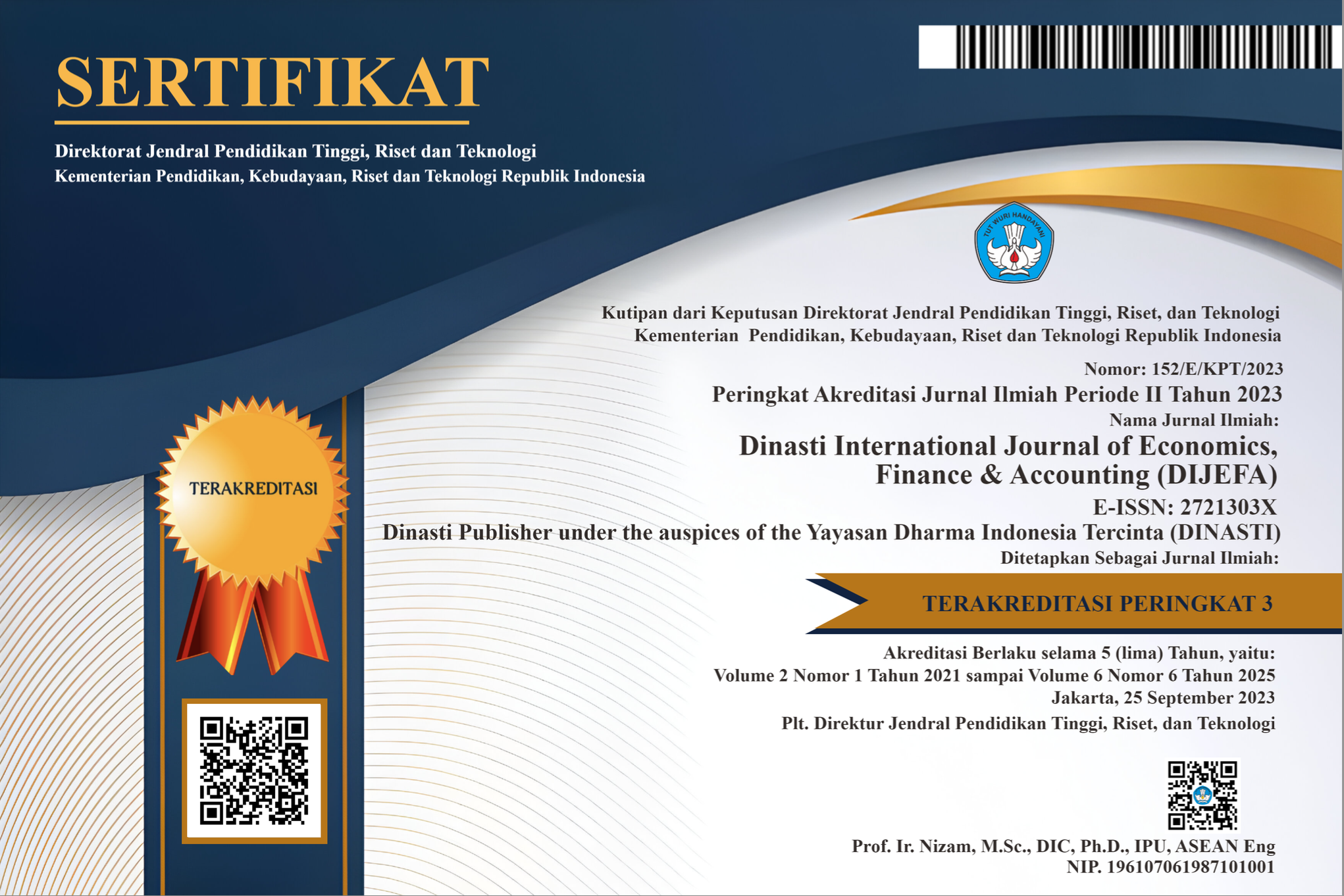Financial Crisis as a Trigger or Amplifier? The Role of Financial Distress in Moderating Hexagon Fraud Factors on Financial Statement Fraud
DOI:
https://doi.org/10.38035/dijefa.v5i5.3407Keywords:
Financial Statement Fraud, Fraud Hexagon, Audit lag, Profitability, Financial DistressAbstract
This study uses financial strain as a moderating variable to examine the relationship between Hexagon Fraud and Financial Statement Fraud. The sample comprises 32 companies in the transportation and logistics sector listed on the Indonesia Stock Exchange for the 2020–2022 period. SEM-PLS was utilized for data analysis. The findings indicate that the danger of financial statement fraud is increased by financial pressure, ineffective monitoring, changes in the director or auditor, ego, and collusion. Financial distress strengthens the effect of auditor and director changes but does not moderate the effect of Ego and Collusion. These findings emphasize the importance of internal control and financial risk management to prevent fraud.
References
Al Badrus, A. (2017). Fraudulent financial statement detection model using pentagon fraud analysis. Jakarta: Faculty of Economics and Business, UIN Syarif Hidayatullah Jakarta.
Apostolou, B.A., Hassell, J.M., Johnson, E.N., & J.R. KUHN, J. (2013). Auditor perceptions of client narcissism as a fraud attitude risk factor. A Journal of Practice & Theory, 32(1), 203–219.
Bamber, E.M., Bamber, L.S., & Schoderbek, M.P. (1993). Audit structure and other determinants of audit report lag: An empirical analysis. Auditing: A Journal of Practice & Theory, 12(1).
Cressey, D. R. (1953). Other people's money; a study of the social psychology of embezzlement.
Dechow, P. M., Ge, W., Larson, C. R., & Sloan, R. G. (2011). Predicting material accounting misstatements. Contemporary Accounting Research, 28(1), 17–82.
Habib, A., Uddin Bhuiyan, B., & Islam, A. (2013). Financial distress, earnings management and market pricing of accruals during the global financial crisis. Managerial Finance, 39(2), 155–180.
Hai, D.H., & Trung, N.S. (2016). The factors affecting the quality of financial statements audit in Vietnam businesses. Asian Social Science, 12(1), 172–181. https://doi.org/10.5539/ass.v12n1p172
Hair, J.F., Howard, M.C., & Nitzl, C. (2019). Assessing measurement model quality in PLS-SEM using confirmatory composite analysis. Journal of Business Research. https://Doi.Org/10.1016/j.Jbusres, 69.
Hartono, D. (2016). Printed Teaching Material Module: PSYCHOLOGY. Jakarta: Health Human Resources Education Center.
Herviana, E. (2017). Fraudulent financial reporting: testing the pentagon fraud theory on state-owned enterprises (BUMN) listed on the Indonesia Stock Exchange (BEI) for the period 2012-2016. Jakarta: Faculty of Economics and Business, UIN Syarif Hidayatullah Jakarta.
Hidayat, I., Ismail, T., Taqi, M., & Yulianto, AS (2023). The effects of environmental costs, environmental disclosure and environmental performance on company value with an independent board of commissioners as moderation. International Journal of Energy Economics and Policy, 13(3), 367–373.
Hsu, Y., & Yang, Y. (2022). Corporate governance and financial reporting quality during the COVID-19 pandemic. Finance Research Letters, 47(PB), 102778. https://doi.org/10.1016/j.frl.2022.102778
Indarto, SL, & Ghozali, I. (2016). Fraud diamond: Detection analysis on the fraudulent financial reporting. Risk Governance & Control: Financial Markets & Institutions, 6(4).
Jensen, M. C., & Meckling, W. H. (1976). Also published in Foundations of Organizational Strategy. Journal of Financial Economics, 4, 305–360. http://ssrn.com/abstract=94043Electroniccopyavailableat:http://ssrn.com/abstract=94043http://hupress.harvard.edu/catalog/JENTHF.html
Jones, J.M., Stone, M., Sulaeman, H., Fink, R. V, Dave, H., Levy, M.E., Di Germanio, C., Green, V., Notari, E., & Saa, P. (2021). Estimated US infection- and vaccine-induced SARS-CoV-2 seroprevalence based on blood donations, July 2020-May 2021. Jama, 326(14), 1400–1409.
Knechel, W.R., & Payne, J.L. (2001). Additional evidence on audit report lag. Auditing: A Journal of Practice & Theory, 20(1), 137–146.
Mangala, D., & Soni, L. (2023). A systematic literature review on frauds in the banking sector. Journal of Financial Crime, 30(1), 285–301.
Murphy, P. R., & Free, C. (2016). Broadening the fraud triangle: Instrumental climate and fraud. Behavioral Research in Accounting, 28(1), 41–56.
Ozili, P. K. (2015). Forensic Accounting and Fraud: A Review of Literature and Policy Implications. International Journal of Accounting and Economics Studies, 3(1), 63–68.
Pering, IMAA (2020). Path Analysis Study Using Structural Equation Modeling (Sem) Smart-Pls 3.0. Satyagraha Scientific Journal, 3(2), 28–48.
Rachmawati, KK, & Marsono, M. (2014). The influence of factors in the fraud triangle perspective on fraudulent financial reporting (Case study on companies based on sanctions from Bapepam for the period 2008-2012). Faculty of Economics and Business.
Rezaee, Z. (2005). Causes, consequences, and deterrence of financial statement fraud. Critical Perspectives on Accounting, 16(3), 277–298.
Sagala, SG, & Siagian, V. (2021). The Influence of the Fraud Hexagon Model on Fraudulent Financial Reports in Food and Beverage Sub-Sector Companies Listed on the IDX in 2016-2019. Journal of Accounting, 13(2), 245–259. https://doi.org/10.28932/jam.v13i2.3956
Saputra, D., Abrar, A., & Rinaldy, RA (2024). THE INFLUENCE OF COMPUTER-ASSISTED AUDIT TECHNIQUES (CAAT) ON THE USE OF HEURISTIC METHODS BY AUDITORS. Management Studies and Entrepreneurship Journal (MSEJ), 5(2), 6673–6686.
Sari, SP, & Nugroho, NK (nd). Financial Statements Fraud with Vousinas Fraud Hexagon Model Approach: A Review of Public Companies in Indonesia. 409–430.
Siska, S., Zulhelmy, Z., Hidayat, R., & Yusniawati, E. (2024). Spirituality's Role in Weakening Intentions For Accounting Fraud. Journal of Contemporary Accounting Research (JRAK), 16(1), 133–146.
Skousen, C. J., Smith, K. R., & Wright, C. J. (2009). Detecting and predicting financial statement fraud: The effectiveness of the fraud triangle and SAS No. 99. In Corporate governance and firm performance (pp. 53–81). Emerald Group Publishing Limited.
Vousinas, G.L. (2019). Advancing theory of fraud: the SCORE model. Journal of Financial Crime, 26(1), 372–381. https://doi.org/10.1108/JFC-12-2017-0128
Wolfe, D.T., & Hermanson, D.R. (2004). The Fraud Diamond : Considering the Four Elements of Fraud. 12, 38–42.
Yusrianti, H., Ghozali, I., Yuyetta, E., Aryanto, & Meirawati, E. (2020). Financial statement fraud risk factors of fraud triangle: Evidence from Indonesia. International Journal of Financial Research, 11(4), 36–51. https://doi.org/10.5430/ijfr.v11n4p36
Yusuf, M. (2022). The Influence of Promotion, Lifestyle, and Risk Perception on Purchase Intention of Electric Motorcycles using the SEM-PLS Method. G-Tech: Journal of Applied Technology, 6(2), 241–248.
Downloads
Published
How to Cite
Issue
Section
License
Copyright (c) 2024 Reza Ananda Rinaldy, Dian Saputra

This work is licensed under a Creative Commons Attribution 4.0 International License.
Authors who publish their manuscripts in this journal agree to the following conditions:
- The copyright on each article belongs to the author(s).
- The author acknowledges that the Dinasti International Journal of Economics, Finance & Accounting (DIJEFA) has the right to be the first to publish with a Creative Commons Attribution 4.0 International license (Attribution 4.0 International (CC BY 4.0).
- Authors can submit articles separately, arrange for the non-exclusive distribution of manuscripts that have been published in this journal into other versions (e.g., sent to the author's institutional repository, publication into books, etc.), by acknowledging that the manuscript has been published for the first time in the Dinasti International Journal of Economics, Finance & Accounting (DIJEFA).


























































